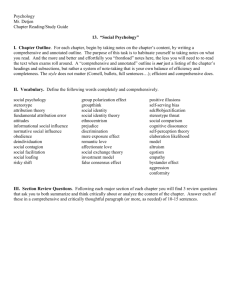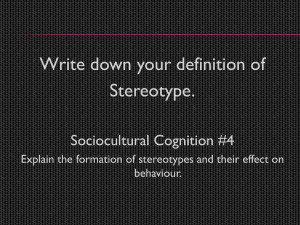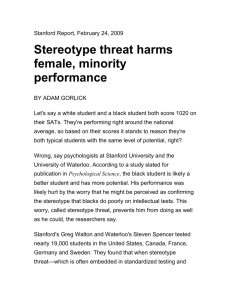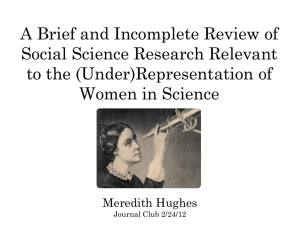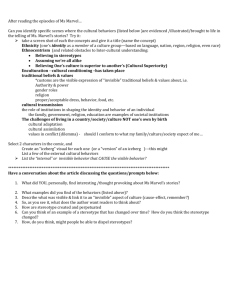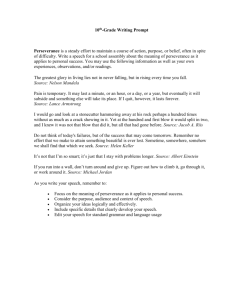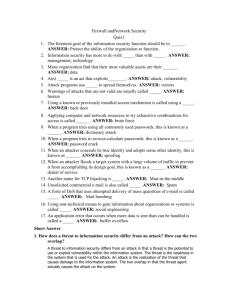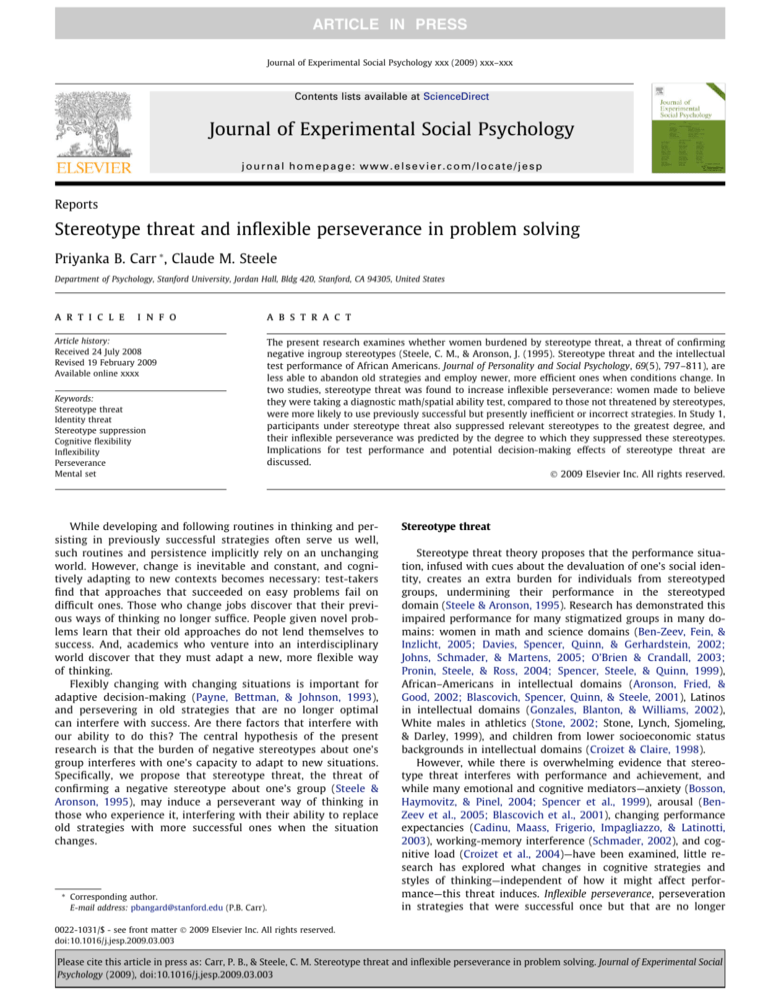
ARTICLE IN PRESS
Journal of Experimental Social Psychology xxx (2009) xxx–xxx
Contents lists available at ScienceDirect
Journal of Experimental Social Psychology
journal homepage: www.elsevier.com/locate/jesp
Reports
Stereotype threat and inflexible perseverance in problem solving
Priyanka B. Carr *, Claude M. Steele
Department of Psychology, Stanford University, Jordan Hall, Bldg 420, Stanford, CA 94305, United States
a r t i c l e
i n f o
Article history:
Received 24 July 2008
Revised 19 February 2009
Available online xxxx
Keywords:
Stereotype threat
Identity threat
Stereotype suppression
Cognitive flexibility
Inflexibility
Perseverance
Mental set
a b s t r a c t
The present research examines whether women burdened by stereotype threat, a threat of confirming
negative ingroup stereotypes (Steele, C. M., & Aronson, J. (1995). Stereotype threat and the intellectual
test performance of African Americans. Journal of Personality and Social Psychology, 69(5), 797–811), are
less able to abandon old strategies and employ newer, more efficient ones when conditions change. In
two studies, stereotype threat was found to increase inflexible perseverance: women made to believe
they were taking a diagnostic math/spatial ability test, compared to those not threatened by stereotypes,
were more likely to use previously successful but presently inefficient or incorrect strategies. In Study 1,
participants under stereotype threat also suppressed relevant stereotypes to the greatest degree, and
their inflexible perseverance was predicted by the degree to which they suppressed these stereotypes.
Implications for test performance and potential decision-making effects of stereotype threat are
discussed.
! 2009 Elsevier Inc. All rights reserved.
While developing and following routines in thinking and persisting in previously successful strategies often serve us well,
such routines and persistence implicitly rely on an unchanging
world. However, change is inevitable and constant, and cognitively adapting to new contexts becomes necessary: test-takers
find that approaches that succeeded on easy problems fail on
difficult ones. Those who change jobs discover that their previous ways of thinking no longer suffice. People given novel problems learn that their old approaches do not lend themselves to
success. And, academics who venture into an interdisciplinary
world discover that they must adapt a new, more flexible way
of thinking.
Flexibly changing with changing situations is important for
adaptive decision-making (Payne, Bettman, & Johnson, 1993),
and persevering in old strategies that are no longer optimal
can interfere with success. Are there factors that interfere with
our ability to do this? The central hypothesis of the present
research is that the burden of negative stereotypes about one’s
group interferes with one’s capacity to adapt to new situations.
Specifically, we propose that stereotype threat, the threat of
confirming a negative stereotype about one’s group (Steele &
Aronson, 1995), may induce a perseverant way of thinking in
those who experience it, interfering with their ability to replace
old strategies with more successful ones when the situation
changes.
* Corresponding author.
E-mail address: pbangard@stanford.edu (P.B. Carr).
Stereotype threat
Stereotype threat theory proposes that the performance situation, infused with cues about the devaluation of one’s social identity, creates an extra burden for individuals from stereotyped
groups, undermining their performance in the stereotyped
domain (Steele & Aronson, 1995). Research has demonstrated this
impaired performance for many stigmatized groups in many domains: women in math and science domains (Ben-Zeev, Fein, &
Inzlicht, 2005; Davies, Spencer, Quinn, & Gerhardstein, 2002;
Johns, Schmader, & Martens, 2005; O’Brien & Crandall, 2003;
Pronin, Steele, & Ross, 2004; Spencer, Steele, & Quinn, 1999),
African–Americans in intellectual domains (Aronson, Fried, &
Good, 2002; Blascovich, Spencer, Quinn, & Steele, 2001), Latinos
in intellectual domains (Gonzales, Blanton, & Williams, 2002),
White males in athletics (Stone, 2002; Stone, Lynch, Sjomeling,
& Darley, 1999), and children from lower socioeconomic status
backgrounds in intellectual domains (Croizet & Claire, 1998).
However, while there is overwhelming evidence that stereotype threat interferes with performance and achievement, and
while many emotional and cognitive mediators—anxiety (Bosson,
Haymovitz, & Pinel, 2004; Spencer et al., 1999), arousal (BenZeev et al., 2005; Blascovich et al., 2001), changing performance
expectancies (Cadinu, Maass, Frigerio, Impagliazzo, & Latinotti,
2003), working-memory interference (Schmader, 2002), and cognitive load (Croizet et al., 2004)—have been examined, little research has explored what changes in cognitive strategies and
styles of thinking—independent of how it might affect performance—this threat induces. Inflexible perseverance, perseveration
in strategies that were successful once but that are no longer
0022-1031/$ - see front matter ! 2009 Elsevier Inc. All rights reserved.
doi:10.1016/j.jesp.2009.03.003
Please cite this article in press as: Carr, P. B., & Steele, C. M. Stereotype threat and inflexible perseverance in problem solving. Journal of Experimental Social
Psychology (2009), doi:10.1016/j.jesp.2009.03.003
ARTICLE IN PRESS
2
P.B. Carr, C.M. Steele / Journal of Experimental Social Psychology xxx (2009) xxx–xxx
efficient, may be one such change that follows from stereotype
threat.
Stereotype threat and inflexible perseverance
Flexibly abandoning old strategies and generating new ones requires many processes. If the context has changed and requires
new strategies, the problem solver must notice the shift in context.
In addition, the problem solver must have the cognitive resources
to inhibit the previous response and develop a new response.
Much research has shown that, as imperfect information processers, people are generally prone to inflexibility: for example, we
apply non-relevant past experiences to present situations (Gilovich, 1981), we try to confirm pre-existing hypotheses (Nickerson,
1998), and we persist in mental sets (Luchins & Luchins, 1994).
The research we review below suggests that stereotype threat
may exacerbate these tendencies and contribute to inflexible
perseverance.
Stress and arousal
Stereotype threat increases anxiety and arousal (Ben-Zeev et al.,
2005; O’Brien & Crandall, 2003; Spencer et al., 1999) and triggers a
physiological stress response (Blascovich et al., 2001; Murphy,
Steele, & Gross, 2007). This high stress and arousal, which tends
to narrow attention to more focal, stress-related cues (Easterbrook,
1959; Murphy et al., 2007; Wells & Matthews, 1994), may render a
stereotype-threatened individual more likely to miss cues in the
environment signaling that the testing situation has changed and
a new strategy is more adaptive: as attention is drawn to cues signaling an identity threat, attention may be drawn away from the
environment. Thus, those stressed and aroused by stereotype
threat may be less likely to adapt a new strategy in a changed
situation.
Ego depletion and working memory
Stereotype threat, associated with resource-demanding tasks
such as stereotype suppression (Logel, Iserman, Davies, Quinn, &
Spencer, 2008; Wenzlaff & Wegner, 2000), leads to ego depletion
(Inzlicht, McKay, & Aronson, 2006) and working-memory depletion
(Schmader & Johns, 2003). Ego-depletion and working-memory
interference are states in which cognitive resources necessary for
successful performance and generating new solutions (Crinella &
Yu, 1999) are drained. Furthermore, working-memory interference
leads to difficulty inhibiting prepotent responses (Kane, Bleckley,
Conway, & Engle, 2001; Kane & Engle, 2003). Therefore, individuals
experiencing stereotype threat may not have the resources to generate new responses and inhibit previous ones.
Prevention focus
Being primed with stigmatized identities (Oyserman, Uskul,
Yoder, Nesse, & Williams, 2007) and experiencing stereotype
threat (Seibt & Forster, 2004) have been found to increase prevention focus, a state associated with concerns about responsibility
and safety and cued when safety needs are made salient (Higgins,
1997). Prevention focus creates a risk-averse style of behavior that
is not explorative and is committed to avoiding errors (Crowe &
Higgins, 1997; Higgins, 1996). Stereotype threat cuing prevention
focus, therefore, may lead to reluctance to deviate from what is
known to be correct and to difficulty generating novel approaches.
In support of this hypothesis, Seibt and Forster (2004) found that
inducing prevention focus through negative stereotypes leads to
decreased creativity.
The present research
The above research leads us to hypothesize that threat may produce inflexible perseverance. In two studies, using different measures of perseverance, we test whether stereotype threat leads its
target to perseverate in previously successful strategies that are no
longer optimal or correct. In Study 1, we also test whether the unique
experience of stereotype threat—contending with negative stereotypes—fosters inflexible perseverance. In Study 2, we test whether
stereotype threat leading to concern about making mistakes (one
aspect of prevention focus) fosters inflexible perseverance.
Study 1
Method
Participants and design
Men (N = 39) and women (N = 28) were randomly assigned to a
diagnostic math test (20 men, 14 women) or a non-diagnostic puzzle (19 men, 14 women) condition.1 All participants were undergraduates at Stanford University and participated in exchange for
$10 or partial course credit.
Participants completed a modified Luchins’ Water-Jar task
(Luchins, 1942) to measure perseverance followed by a lexical
decision task to measure stereotype suppression. Mood, performance expectancy, liking, and motivation measures followed.
Participants completed domain-identification measures at pretesting, several weeks before the experiment. Only those moderate
to high (score at 5 or greater on a 7-point scale for each of our two
domain-identification measures) in identification were invited for
participation because stereotype threat effects are weak or nonexistent among those who do not care about the domain (Aronson
et al., 1999).
Threat manipulation
All participants took the same test (the Water-Jar task). Participants in the diagnostic condition read that the test was developed
by a prestigious organization and was a highly validated measure
of mathematical ability. Participants indicated their gender before
they started the test.
Participants in the non-diagnostic condition read that the task
was a puzzle-solving exercise, developed by students and used to
gain insight into how people solve puzzles. They were told it produced no gender differences. These participants indicated their
gender after the task.
Measures
Perseverance: Water-Jar task. The Water-Jar task has been widely
used to study perseveration in mental set and thus lends itself well
to our study of inflexible perseverance (Luchins & Luchins, 1994;
Schultz & Searleman, 2002). In our computerized version of the
Water-Jar task, participants were told they had a barrel full of
water and a pot which they needed to fill with a desired quantity
of water. To get the desired quantity of water, they could use three
jars (A, B, C) each of which could hold a certain quantity of water.
Participants were instructed to generate the simplest strategy as
quickly as possible for getting the desired quantity and to not
use any jar more than three times in a problem. A strategy of
2A + 2C would mean that the pot should be filled using Jar A twice
and using Jar C twice to get the desired quantity.
After an example problem, participants were given three practice problems that had novel solutions that did not overlap with
1
Originally, 44 men and 44 women participated. While we invited only those who
were math-identified to participate, through sharing of passwords, those low in math
identification were able to participate. We excluded participants with low math
identification.
Please cite this article in press as: Carr, P. B., & Steele, C. M. Stereotype threat and inflexible perseverance in problem solving. Journal of Experimental Social
Psychology (2009), doi:10.1016/j.jesp.2009.03.003
ARTICLE IN PRESS
P.B. Carr, C.M. Steele / Journal of Experimental Social Psychology xxx (2009) xxx–xxx
3
test trial solutions. During the test trials, participants were presented with six ‘‘set-establishing” trials in which the fairly complex
strategy of B–A–2C was the only successful solution. Five ‘‘Critical”
trials in which the old, complex strategy still reached the solution,
but there was also a simpler, more efficient way to do so (e.g., A–C)
followed. Because perseverance in mental set occurs at high rates
in non-threatening conditions (see Luchins & Luchins, 1994;
Schultz & Searleman, 2002), we modified the test to tap extreme
perseverance. The last three critical trials were very obvious about
the simple solution: an obvious trial may ask for five cups when Jar
A holds 20 and Jar C holds 15; a non-obvious trial may ask for 14
cups when Jar A holds 32 and Jar C 18.
Stereotype suppression: lexical decision task. Research has found that
stereotype threat leads to activation of the relevant stereotype before a threatening test begins (Davies et al., 2002). However, once
the threatening task begins, those targeted by the stereotype engage in stereotype suppression, exerting effort to push negative
stereotypes out of conscious awareness. Research using a lexical
decision task found that those who were stereotype-threatened,
compared to those not threatened, responded slower to stereotypic
words during the threatening task, indicating they were exerting
effort to suppress the relevant stereotype (Logel et al., 2008). We
presented the lexical decision task in our study at the very end
of our measure and suggest it is a continuation of the task. Thus,
we expected evidence for suppression under stereotype threat.
The lexical decision task asks participants to judge whether a
string of letters is a word or a non-word. A list of words associated
with negative stereotypes about women in math and words not
associated with the stereotype but matched for length and frequency of usage (using norms established by Kucera & Francis,
1967) were rated by 50 undergraduates for their relevance to stereotypes about women in math. The 10 words that were rated as
most associated were chosen to be our ‘‘stereotypic” words (inferior, weak, slow, dumb, stupid, woman, female, lesser, deficient,
inadequate). The 10 ‘‘non-stereotypic” words (disagree, curt, nose,
debt, firing, voice, wooden, denial, animosity, reflection) were
rated as low in association. We also generated 10 non-words
matched for length.
Participants were presented with the stimuli in randomized order on a computer. Participants saw the following order of events:
a fixation cross for 300 ms, a blank screen for 500 ms, the target array of letters until a word or non-word decision was made, and a
blank screen for 1000 ms.
Performance expectancy. Participants were given our stereotype
suppression measure after the perseverance measure to ensure
we did not prime perseverance. We asked participants to rate on
a scale of 1 (not well at all) to 7 (extremely well) how well they
thought they performed on the Water-Jar task to make certain that
perceived performance did not predict stereotype suppression.
Math identification. Participants rated on a scale of 1 (not at all true
of me) to 7 (very true of me) two statements assessing math identification: ‘‘I am good at math” and ‘‘It is important to me that I do
well at math”.
Other measures. To rule out alternative explanations, we included a
mood measure (PANAS; Watson, Clark, & Tellegen, 1988) and measured participants’ liking for and motivation to do well on the
Water-Jar task.
Results and summary
One female participant (in the non-diagnostic condition) was
excluded for not following instructions.
Fig. 1. Probability of being classified as high in perseverance by condition, derived
from logistic regression.
Set establishment
All participants established set, using B–A–2C on at least four of
the six set-establishing trials.
Does identity threat lead to inflexible perseverance?
We hypothesized that women in the diagnostic condition
would be most perseverant. Diagnosticity should not have the
same effect on men, for whom the math test is not identity threatening. The Water-Jar task was designed so that the last three critical trials made the simple solution very obvious. We did so to
make this measure more sensitive to condition effects as people
in general have a strong tendency to maintain set.2
To tap perseverance, we created the variable, ‘‘perseverance
level.” Participants who used the set solution on at least one of
these last three Critical trials—trials in which the easier solution
is obvious—were categorized as high in perseverance. Participants
who used the set solution on none of the last three critical trials
were classified as low in perseverance.
A logistic regression, controlling for math identification, revealed
that women (b = !2.07, odds-ratio = .13, p < .05) and those in the
diagnostic condition (b = !1.4, odds-ratio = .243, p = .078), in general, were less likely to show high perseverance. These main effects
were qualified by a gender by condition interaction, (b = 3.28, oddsratio = 26.44, p < .05), with those in the stereotype threat cell
(women in the diagnostic condition) more likely to be high in perseverance.3 Entering the interaction term in the model made it a significantly better predictor of level of perseverance (Dv2 = 7.38, p < .01).
The estimated probabilities from the logistic regression (see
Fig. 1) revealed that women in the diagnostic condition were more
likely (probability = .774) to be high in perseverance than women in
the non-diagnostic condition (probability = .347, Dv2 = 4.05, p < .05;
b = .93, odds-ratio = 2.54, p < .05). The means also revealed a trend
in the opposite direction for men: men in the diagnostic condition
2
Including the last three trials with obvious solutions allowed us to analyze the
data in a way that minimizes variance in solutions created by differences in individual
problems. Our concern about variance created by differences in individual problems
was borne out. Our logistic regression analysis using a dichotomous variable yielded a
significant interaction. We also analyzed the data by examining the effects of gender
and condition on the total number of critical trials solved using the set solution. A 2
(male or female) " 2 (diagnostic or non-diagnostic) ANCOVA, controlling for math
identification, revealed the same pattern of results as the logistic regression.
However, the gender by condition interaction was only marginally significant,
F(1, 61) = 3.28, p = .075. Women in the diagnostic condition tended to solve more
problems with the set solution (Madj = 2.59) than women who were not threatened
(Madj = 1.89, t(61) = 1.24, p > .2). Men in the diagnostic condition (Madj = 2.15) tended
to solve fewer problems with the set solution than men in the non-diagnostic
condition (Madj = 2.80, t(61) = 1.74, p > .15).
3
The gender by condition interaction term essentially contrasts the stereotype
threat cell (coded as 1) with all other cells (coded as 0).
Please cite this article in press as: Carr, P. B., & Steele, C. M. Stereotype threat and inflexible perseverance in problem solving. Journal of Experimental Social
Psychology (2009), doi:10.1016/j.jesp.2009.03.003
ARTICLE IN PRESS
4
P.B. Carr, C.M. Steele / Journal of Experimental Social Psychology xxx (2009) xxx–xxx
the stereotype the most) were more likely to be classified as high
in perseverance. However, men in the diagnostic condition showed
the opposite pattern: men who were faster to react to the stereotypic words (presumably men who were activating the concept of
incompetence) were marginally more likely to be classified as high
in perseverance (Dv2 = 3.522, p = .06; b = !.01, odds-ratio = .99,
p = .13). In the non-diagnostic condition perseverance was not correlated with time to lexically classify stereotypic words (ps > .25).
Other analyses
Participants’ mood, performance estimates, liking, and motivation did not predict perseverance level or reaction time on the lexical decision task, Fs < 1.
Fig. 2. Reaction time to lexically classify words related to negative stereotypes
about women in math (controlling for reaction time to non-stereotypic words) by
condition.
were less likely to be high in perseverance (probability = .506) than
men in the non-diagnostic condition (probability = .808, Dv2 = 3.15,
p = .076; b = !.65, odds-ratio = .524, p = .084).
Does identity threat lead to stereotype suppression?
Drawing from Logel et al. (2008), when participants in one condition take a significantly longer amount of time to decide if a stereotypic word is a word, we can infer that they are trying to
suppress the stereotype to a greater degree.
All trials in which participants made an incorrect response or
had reaction times less than 200 ms or more than 2000 ms (1.2%
of trials) were excluded. A 2 (male or female) " 2 (diagnostic or
non-diagnostic) ANCOVA examining reaction time to classify stereotypic words, with reaction time for the classification of non-stereotypic words as a covariate, revealed a gender by condition
interaction, F(1, 61) = 4.59, p < .05.4 There were no main effects for
condition or gender, Fs < 1.
As Fig. 2 reveals, women in the diagnostic condition took significantly longer to classify stereotypic words (Madj = 870.3 ms) than
men in the diagnostic condition (Madj = 693.7 ms, t(61) = 2.14,
p < .05), evidencing effort to suppress negative stereotypes under
threat. They also tended to take longer to classify stereotypic words
than women in the non-diagnostic condition (Madj = 722.4 ms,
t(61) = 1.79, p = .07) but not men in the non-diagnostic condition
(Madj = 835.1 ms, t < 1).
Does stereotype suppression predict perseverance?
We examined whether the reaction time to stereotypic words
significantly predicted classification as high or low in perseverance.
A logistic regression revealed that time taken to lexically classify
stereotypic words did not significantly predict classification as
high or low in perseverance (Dv2 = 1.17, p = .28; b = .001, odds-ratio = 1.0, p > .25).
However, we did not expect the effect of stereotype suppression
to evidence itself across all groups: those in the non-diagnostic condition and men, in general, may not be much affected by suppressing words related to incompetence. Thus, we conducted the
previous analysis separately for each of the four cells in our study.
This analysis revealed that, for women in the diagnostic condition,
time taken to lexically classify a stereotypic word was a significant
predictor of classification as high or low in perseverance (Dv2 = 6.0,
p < .05; b = .01, odds-ratio = 1.01, p = .15). Women who took longer
to react to the stereotypic words (women who were suppressing
4
Excluding stereotypic words ‘‘female” or ‘‘woman” from the analysis did not
change the significance or pattern of results.
Summary
In Study 1, we find that stereotype threat leads to greater probability of engaging in inflexible perseverance and increased effort
to suppress stereotypes. Illuminating that the process is indeed driven by concerns about negative stereotypes, we find that perseverance by stereotype-threatened participants is correlated with their
stereotype suppression.
Study 2
In Study 2, we conceptually replicate the first study using a different measure of perseverance, the Wisconsin Card Sorting Test
(WCST), an even more widely used measure of perseveration.
A weakness of Study 1 was that the condition effect, though larger for women, was almost as large for men, albeit in the opposite
direction. We posit that this finding may be akin to the effects of
stereotype lift, whereby the non-threatened group performs better
in the diagnostic condition compared to the non-diagnostic condition, and that flexibility may be a mechanism through which stereotype lift operates. While, in general, stereotype threat effects
are much larger than those of stereotype lift, individual studies
have occasionally found stereotype lift effects as large as those of
stereotype threat (see Walton & Cohen, 2003). We expect a second
study to show effects of stereotype threat—gender differences in
the diagnostic condition and condition differences for women.
However, we do not expect to replicate the relatively rare magnitude of stereotype lift effects from Study 1. These findings would
clarify that the inflexible perseverance effect is driven by stereotype threat and individuals who are threatened.
In the second study, we also do not measure stereotype suppression, which did not mediate our effect in all cells in the first
study, but instead examine another potential mediator—activation
of thoughts related to making mistakes. Being concerned with
making mistakes might lead participants to avoid giving up a strategy that has had a history of success. Stereotype threat has been
found to increase prevention focus and one aspect of prevention
focus is concern with mistakes and errors. Thus, in Study 2, we
measure activation of words related to making mistakes as a potential mediator.
Method
Participants and design
As in Study 1, moderately to highly math-identified men
(N = 32) and women (N = 31) were randomly assigned to a diagnostic math/spatial ability test (17 men, 13 women) or non-diagnostic
puzzle (15 men, 18 women) condition.5 All participants were
5
Twenty-one participants (11 men, 10 women) who participated from an
introductory psychology class after hearing a lecture on stereotype threat were
excluded.
Please cite this article in press as: Carr, P. B., & Steele, C. M. Stereotype threat and inflexible perseverance in problem solving. Journal of Experimental Social
Psychology (2009), doi:10.1016/j.jesp.2009.03.003
ARTICLE IN PRESS
P.B. Carr, C.M. Steele / Journal of Experimental Social Psychology xxx (2009) xxx–xxx
5
undergraduates at Stanford University and participated in exchange
for $10 or partial course credit. Participants completed the WCST to
measure perseverance, followed by a lexical decision task to measure activation of mistake-related words. Mood, performance expectancy, liking, and motivation measures followed.
Threat manipulation
Threat was manipulated as in Study 1, with the only difference
being that the diagnostic test (the WCST) was described as a test of
spatial and analytical ability predictive of success in mathematical
and spatial fields.
Measures
Perseverance: Wisconsin card sorting test. The WCST (Berg, 1948) is a
widely used test of the ability to flexibly shift in the face of changing
situations and contingencies. In our modified and computerized
version of the WCST, the participant is presented with a target card
with a picture on it (e.g., two yellow stars) and the participant is
asked to match this card to one of four cards that vary in the number,
color, and shape of objects depicted (specifically, one red circle, two
green stars, three blue squares, and four yellow pluses). The sorting
rule (match by number, color or shape) is not revealed to the participant, but is to be deciphered through accuracy feedback. The rule
changes after 10 correct sorts, and the participant must deduce
and sort by the new rule. Participants receive between 84 and 128
trials and between 5 and 9 shifts in the sorting rule. The number
of errors and perseverative errors (errors that match on the basis
of the previous sorting rule after a rule shift) are recorded.
‘‘Mistake” activation: lexical decision task. The lexical decision task
to measure activation of thoughts related to mistakes was structured as in Study 1, except the target words were about ‘‘mistakes”
(mistake, error, inaccurate, blunder, incorrect, wrong, imperfect,
miscalculation, flaw, careless) and the matched control words were
unrelated to that construct (dispute, dirty, hemorrhage, hostage,
poisonous, piece, repulsive, culture, uncontrollable, wail, withdraw). The relatedness of these words to the construct was confirmed through pre-testing with 50 undergraduates.
Other measures. As in Study 1, we measured mood, liking, motivation, and performance expectancy.
Fig. 3. Mean perseverance score (perseverative errors/rule changes) by condition.
activation of ‘‘mistake” words. We would also expect such activation to correlate with perseverance. However, we failed to find
support for this account. After excluding all incorrect trials and trials with reaction times below 200 ms and above 2000 ms (1% of
trials), an ANCOVA, with the mean response time for classification
of mistake-unrelated words as a covariate, revealed no significant
gender by condition interaction or main effects for classification
of mistake-related words, Fs < 1. Correlations of reaction time with
perseverance scores were not significant across participants or
within-cell, ps > .2
Other analyses
Participants’ mood, performance estimates, liking, and motivation did not predict perseverance or reaction time, Fs < 1.
Summary
Further supporting our hypothesis, we found in a different paradigm that stereotype threat causes its targets to be perseverant.
However, we failed to find support for the prediction that thinking
about mistakes drives the perseverance effect.
Discussion
Results and summary
Does stereotype threat lead to inflexible perseverance?
We expected women in the diagnostic condition to be most
perseverant on the WCST. We calculated a mean perseverance
score for each participant by dividing the number of perseverative
errors the participant made by the number of sorting rule shifts
experienced by the participant. This score tells us on average
how many trials a participant perseverated in the previous sorting
rule after the sorting rule had changed.
An ANOVA revealed the expected gender by condition interaction, F(1, 59) = 6.05, p < .05. There were no significant main effects.
Women in the diagnostic condition had the highest perseverance
scores (M = 3.25), significantly higher than those of women in the
non-diagnostic condition (M = 1.75, t(59) = 2.42, p < .05) and those
of men in the diagnostic condition (M = 1.78, t(59) = 2.36, p < .05).
Men did not significantly differ by condition (M = 2.40 for men in
the non-diagnostic cell) and there was no significant gender difference in the non-diagnostic condition, ps > .2 (see Fig. 3).
Does stereotype threat lead to thinking about mistakes? Does thinking
about mistakes predict perseverance?
If concern with making mistakes was driving our effect, we
might expect women in the diagnostic cell to show the greatest
How do cognitive strategies and behaviors change pursuant to
threat? In two studies, using two different measures of perseverance, we show that stereotype threat pressures people toward
inflexible perseverance in a problem-solving strategy that is no
longer optimal or correct. Moreover, in the first study, we found
that the degree to which stereotype-threatened individuals suppressed stereotypes was associated with their likelihood of being
high in perseverance.
To test performance
Being stereotype-threatened leads to impaired test performance (Steele, 1997). The current research suggests that one reason test performance suffers may be that stereotype threat leads
to inflexibility. Flexibility, which we define as a cognitive state of
mind that allows for adaptation and change, is important for successful decision-making (Payne et al., 1993). Flexibility, we imagine, is also important for doing well on standardized tests which
are often designed to prevent mastery by previous learning: from
question to question, new strategies and approaches must be
adapted. It is our hypothesis that inflexible perseverance would
impair performance on such tests and might mediate the effects
of threat on test performance. Flexibility may also be a potential
Please cite this article in press as: Carr, P. B., & Steele, C. M. Stereotype threat and inflexible perseverance in problem solving. Journal of Experimental Social
Psychology (2009), doi:10.1016/j.jesp.2009.03.003
ARTICLE IN PRESS
6
P.B. Carr, C.M. Steele / Journal of Experimental Social Psychology xxx (2009) xxx–xxx
behavioral mediator of stereotype lift effects on test performance.
In Study 1, we found that men tended towards greater flexibility in
the diagnostic condition compared to the non-diagnostic condition. Study 2 did not replicate the magnitude of that effect (as is
to be expected since stereotype lift effects are smaller than those
of stereotype threat) but the means followed the same pattern.
However, further research is needed to demonstrate that inflexibility mediates the effect of threat and lift on test performance.
Discovering behavioral mediators like inflexible perseverance,
though, may be particularly useful in designing interventions to
alleviate the burden faced by those who are under stereotype
threat: interventions could be designed to target specific, tangible
behavior.
Why does threat cause inflexible perseverance?
In our first study, we found significantly increased stereotype
suppression under stereotype threat. We also found that suppression by stereotype-threatened participants was correlated with degree of inflexibility. However, since we did not find mediation, we
examined another potential mediator in Study 2—concern with
mistakes. Our second study failed to find an effect of threat on
thinking about mistakes or any evidence for such thinking predicting inflexibility. Because we did not find complete mediation in our
first study, this research is inconclusive on what drives the effects
of threat on perseverance. However, it is suggestive that stereotype
suppression rather than being concerned with mistakes may be the
most fruitful mediator for future research to consider. Such research could use different measures of stereotype suppression
(for example, post-suppressional rebound) or examine possible effects of suppression as mediators. One such effect may be workingmemory depletion: exerting effort to push stereotypes out of
awareness, as women under stereotype threat seem to be doing,
depletes the limited ego and working-memory resources necessary
for generating new solutions and noticing context changes. Future
research should examine depletion of resources as a more proximal mediator of stereotype threat effects on inflexibility to uncover
the mechanism driving the inflexible perseverance effect.
Beyond test performance
While much research on stereotype threat is focused on test
performance, the current finding that threat results in inflexible
perseverance suggests that threat may affect much more than test
performance. Inflexible mindsets are implicated in many decisionmaking errors such as confirmatory hypothesis testing (Nickerson,
1998), groupthink (Janis, 1972), status-quo bias (Kahneman,
Knetsch, & Thaler, 1991), and escalation of commitment (Staw,
1976). And, identity threats exist beyond the classroom and the
test-taking situation. Women in a technology firm and African–
American CEOs are also faced with threats based on negatively stereotyped identities. Chronically stigmatized minorities, facing an
ongoing and almost ever-present social identity threat spanning
many situations (Steele, Spencer, & Aronson, 2002), may be constantly burdened by identity threat. Thus, stereotype threat, spanning many situations and resulting in a perseverant mindset, may
negatively impact decision-making and job performance.
Our research is limited in that it examines inflexibility in a single domain (a testing domain). It is important for future research to
explore how threat affects mindsets and strategies in other domains. In the domain of decision-making, for example, the current
research would suggest that threat may result in greater susceptibility to the sunk-cost fallacy or escalation of commitment effects:
individuals with a perseverant mindset may be more likely to persist in an initially chosen way, even when that strategy is failing or
costly. Our findings highlight the need to examine the effects of
threat beyond test performance and to alleviate the burden of
threat in domains that extend beyond the classroom door.
Acknowledgments
We thank Tito Balsamo and Nathan Grossman for their assistance with data collection.
References
Aronson, J., Fried, C. B., & Good, C. (2002). Reducing the effects of stereotype threat
on African American college students by shaping theories of intelligence. Journal
of Experimental Social Psychology, 38(2), 113–125.
Aronson, J., Justina, M. J., Good, C., Keough, K., Steele, C. M., & Brown, J.
(1999). When White men can’t do math: Necessary and sufficient factors
in stereotype threat. Journal of Experimental Social Psychology, 35(1),
29–46.
Ben-Zeev, T., Fein, S., & Inzlicht, M. (2005). Arousal and stereotype threat. Journal of
Experimental Social Psychology, 41(2), 174–181.
Berg, E. A. (1948). A simple objective technique for measuring flexibility in thinking.
Journal of General Psychology, 39(1), 15–22.
Blascovich, J., Spencer, S. J., Quinn, D., & Steele, C. (2001). African Americans and
high blood pressure: The role of stereotype threat. Psychological Science, 12(3),
225–229.
Bosson, J. K., Haymovitz, E. L., & Pinel, E. C. (2004). When saying and doing diverge:
The effects of stereotype threat on self-reported versus non-verbal anxiety.
Journal of Experimental Social Psychology, 40(2), 247–255.
Cadinu, M., Maass, A., Frigerio, S., Impagliazzo, L., & Latinotti, S. (2003). Stereotype
threat: The effect of expectancy on performance. European Journal of Social
Psychology, 33(2), 267–285.
Crinella, F. M., & Yu, J. (1999). Brain mechanisms and intelligence: Psychometric ‘‘g”
and executive function. Intelligence, 27(4), 299–327.
Croizet, J., & Claire, T. (1998). Extending the concept of stereotype and threat to
social class: The intellectual underperformance of students from low
socioeconomic backgrounds. Personality and Social Psychology Bulletin, 24(6),
588–594.
Croizet, J., Despres, G., Gauzins, M., Huguet, P., Leyens, J., & Moet, A. (2004).
Stereotype threat undermines intellectual performance by triggering a
disruptive mental load. Personality and Social Psychology Bulletin, 30(6),
721–731.
Crowe, E., & Higgins, E. T. (1997). Regulatory focus and strategic inclinations:
Promotion and prevention in decision making. Organizational Behavior and
Human Decision Processes, 69, 117–132.
Davies, P. G., Spencer, S. J., Quinn, D. M., & Gerhardstein, R. (2002). Consuming
images: How television commercials that elicit stereotype threat can restrain
women academically and professionally. Personality and Social Psychology
Bulletin, 28(12), 1615–1628.
Easterbrook, J. A. (1959). The effect of emotion on cue utilization and the
organization of behavior. Psychological Review, 66(3), 183–201.
Gilovich, T. (1981). Seeing the past in the present: The effect of associations to
familiar events on judgments and decisions. Journal of Personality and Social
Psychology, 40, 797–808.
Gonzales, P. M., Blanton, H., & Williams, K. J. (2002). The effects of stereotype threat
and double-minority status on the test performance of Latino women.
Personality and Social Psychology Bulletin, 28(5), 659–670.
Higgins, E. T. (1996). Emotional experiences: The pains and pleasures of distinct
regulatory systems. Hillsdale, NJ: Lawrence Erlbaum.
Higgins, E. T. (1997). Beyond pleasure and pain. American Psychologist, 52(12),
1280–1300.
Inzlicht, M., McKay, L., & Aronson, J. (2006). Stigma as ego depletion: How being
the target of prejudice affects self-control. Psychological Science, 17(3),
262–269.
Janis, I. (1972). Victims of groupthink. Boston, MA: Houghton Mifflin Company.
Johns, M., Schmader, T., & Martens, A. (2005). Knowing is half the battle: Teaching
stereotype threat as a means of improving women’s math performance.
Psychological Science, 16(3), 175–179.
Kahneman, D., Knetsch, J. L., & Thaler, R. H. (1991). Anomalies: The endowment
effect, loss aversion, and status quo bias. The Journal of Economic Perspectives,
5(1), 193–206.
Kane, M. J., Bleckley, M. K., Conway, A. R., & Engle, R. W. (2001). A controlledattention view of working-memory capacity. Journal of Experimental Psychology:
General, 130(2), 169–183.
Kane, M. J., & Engle, R. W. (2003). Working-memory capacity and the control of
attention: The contributions of goal neglect, response competition, and task set
to Stroop interference. Journal of Experimental Psychology: General, 132(1),
47–70.
Kucera, H., & Francis, W. N. (1967). Computational analysis of present-day American
English. Providence, RI: Brown University Press.
Logel, C., Iserman, E. C., Davies, P. G., Quinn, D. M., & Spencer, S. J. (2008). The perils
of double consciousness: The role of thought suppression in stereotype threat.
Journal of Experimental Social Psychology. doi:10.1016/j.jesp.2008.07.016.
Luchins, A. S. (1942). Mechanization in problem-solving: The effect of Einstellung.
Psychological Monographs, 54 (6, Serial No. 248).
Please cite this article in press as: Carr, P. B., & Steele, C. M. Stereotype threat and inflexible perseverance in problem solving. Journal of Experimental Social
Psychology (2009), doi:10.1016/j.jesp.2009.03.003
ARTICLE IN PRESS
P.B. Carr, C.M. Steele / Journal of Experimental Social Psychology xxx (2009) xxx–xxx
Luchins, A. S., & Luchins, E. H. (1994). The water jar experiments and Einstellung
effects: I. Early history and surveys of textbook citations. Gestalt Theory, 16(2),
101–121.
Murphy, M. C., Steele, C. M., & Gross, J. J. (2007). Signaling threat: How situational
cues affect women in math, science, and engineering settings. Psychological
Science, 18(10), 879–885.
Nickerson, R. S. (1998). Confirmation bias: A ubiquitous phenomenon in many
guises. Review of General Psychology, 2(2), 175–220.
O’Brien, L. T., & Crandall, C. S. (2003). Stereotype threat and arousal: Effects on
women’s math performance. Personality and Social Psychology Bulletin, 29(6),
782–789.
Oyserman, D., Uskul, A. K., Yoder, N., Nesse, R. M., & Williams, D. R. (2007). Unfair
treatment and self-regulatory focus. Journal of Experimental Social Psychology,
43(3), 505–512.
Payne, J. W., Bettman, J. R., & Johnson, E. J. (1993). The adaptive decision-maker. New
York, NY: Cambridge University Press.
Pronin, E., Steele, C. M., & Ross, L. (2004). Identity bifurcation in response to
stereotype threat: Women and mathematics. Journal of Experimental Social
Psychology, 40(2), 152–168.
Schmader, T. (2002). Gender identification moderates stereotype threat effects on
women’s math performance. Journal of Experimental Social Psychology, 38(2),
194–201.
Schmader, T., & Johns, M. (2003). Converging evidence that stereotype threat
reduces working memory capacity. Journal of Personality and Social Psychology,
85(3), 440–452.
Schultz, W. P., & Searleman, A. (2002). Rigidity of thought and behavior: 100 years
of research. Genetic, Social, and General Psychology Monographs, 128(2), 165–207.
Seibt, B., & Forster, J. (2004). Stereotype threat and performance: How selfstereotypes influence processing by inducing regulatory foci. Journal of
Personality and Social Psychology, 87(1), 38–56.
7
Spencer, S. J., Steele, C. M., & Quinn, D. M. (1999). Stereotype threat and
women’s math performance. Journal of Experimental Social Psychology, 35(1),
4–28.
Staw, B. M. (1976). Knee-deep in the big muddy: A study of escalating commitment
to a chosen course of action. Organizational Behavior and Human Decision
Processes, 16(1), 27–44.
Steele, C. M. (1997). A threat in the air: How stereotypes shape intellectual identity
and performance. American Psychologist, 52(6), 613–629.
Steele, C. M., & Aronson, J. (1995). Stereotype threat and the intellectual test
performance of African Americans. Journal of Personality and Social Psychology,
69(5), 797–811.
Steele, C. M., Spencer, S. J., & Aronson, J. (2002). Contending with group image: The
psychology of stereotype and social identity threat. In M. P. Zanna (Ed.).
Advances in experimental social psychology (Vol. 34, pp. 379–440). San Diego, CA,
US: Academic Press.
Stone, J. (2002). Battling doubt by avoiding practice: The effects of stereotype threat
on self-handicapping in white athletes. Personality and Social Psychology Bulletin,
28(12), 1667–1678.
Stone, J., Lynch, C. I., Sjomeling, M., & Darley, J. M. (1999). Stereotype threat effects
on Black and White athletic performance. Journal of Personality and Social
Psychology, 77(6), 1213–1227.
Walton, G., & Cohen, G. (2003). Stereotype lift. Journal of Experimental Social
Psychology, 39(5), 456–467.
Watson, D., Clark, L. A., & Tellegen, A. (1988). Development and validation of brief
measures of positive and negative affect: The PANAS scales. Journal of
Personality and Social Psychology, 54(6), 1063–1070.
Wells, A., & Matthews, G. (1994). Attention and emotion: A clinical perspective.
Hillsdale, NJ, England: Lawrence Erlbaum Associates, Inc.
Wenzlaff, R. M., & Wegner, D. M. (2000). Thought suppression. Annual Review of
Psychology, 51, 59–91.
Please cite this article in press as: Carr, P. B., & Steele, C. M. Stereotype threat and inflexible perseverance in problem solving. Journal of Experimental Social
Psychology (2009), doi:10.1016/j.jesp.2009.03.003

